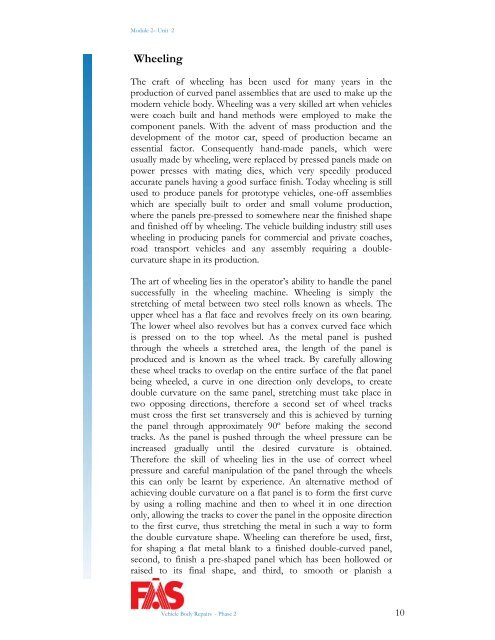TRADE OF VEHICLE BODY REPAIR - eCollege
TRADE OF VEHICLE BODY REPAIR - eCollege
TRADE OF VEHICLE BODY REPAIR - eCollege
You also want an ePaper? Increase the reach of your titles
YUMPU automatically turns print PDFs into web optimized ePapers that Google loves.
Module 2– Unit 2<br />
Wheeling<br />
The craft of wheeling has been used for many years in the<br />
production of curved panel assemblies that are used to make up the<br />
modern vehicle body. Wheeling was a very skilled art when vehicles<br />
were coach built and hand methods were employed to make the<br />
component panels. With the advent of mass production and the<br />
development of the motor car, speed of production became an<br />
essential factor. Consequently hand-made panels, which were<br />
usually made by wheeling, were replaced by pressed panels made on<br />
power presses with mating dies, which very speedily produced<br />
accurate panels having a good surface finish. Today wheeling is still<br />
used to produce panels for prototype vehicles, one-off assemblies<br />
which are specially built to order and small volume production,<br />
where the panels pre-pressed to somewhere near the finished shape<br />
and finished off by wheeling. The vehicle building industry still uses<br />
wheeling in producing panels for commercial and private coaches,<br />
road transport vehicles and any assembly requiring a doublecurvature<br />
shape in its production.<br />
The art of wheeling lies in the operator’s ability to handle the panel<br />
successfully in the wheeling machine. Wheeling is simply the<br />
stretching of metal between two steel rolls known as wheels. The<br />
upper wheel has a flat face and revolves freely on its own bearing.<br />
The lower wheel also revolves but has a convex curved face which<br />
is pressed on to the top wheel. As the metal panel is pushed<br />
through the wheels a stretched area, the length of the panel is<br />
produced and is known as the wheel track. By carefully allowing<br />
these wheel tracks to overlap on the entire surface of the flat panel<br />
being wheeled, a curve in one direction only develops, to create<br />
double curvature on the same panel, stretching must take place in<br />
two opposing directions, therefore a second set of wheel tracks<br />
must cross the first set transversely and this is achieved by turning<br />
the panel through approximately 90º before making the second<br />
tracks. As the panel is pushed through the wheel pressure can be<br />
increased gradually until the desired curvature is obtained.<br />
Therefore the skill of wheeling lies in the use of correct wheel<br />
pressure and careful manipulation of the panel through the wheels<br />
this can only be learnt by experience. An alternative method of<br />
achieving double curvature on a flat panel is to form the first curve<br />
by using a rolling machine and then to wheel it in one direction<br />
only, allowing the tracks to cover the panel in the opposite direction<br />
to the first curve, thus stretching the metal in such a way to form<br />
the double curvature shape. Wheeling can therefore be used, first,<br />
for shaping a flat metal blank to a finished double-curved panel,<br />
second, to finish a pre-shaped panel which has been hollowed or<br />
raised to its final shape, and third, to smooth or planish a<br />
Vehicle Body Repairs - Phase 2 10
















